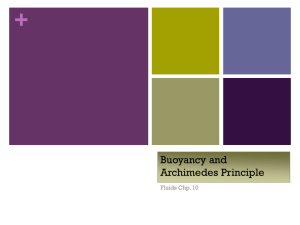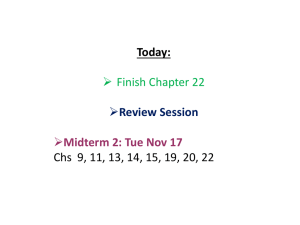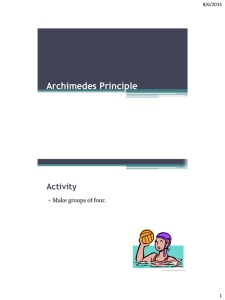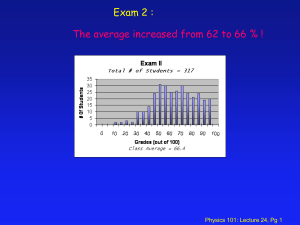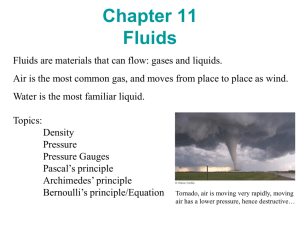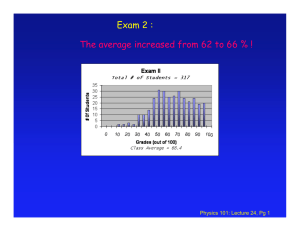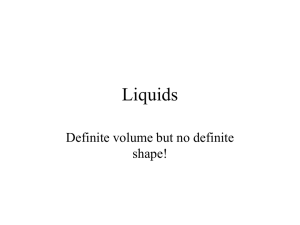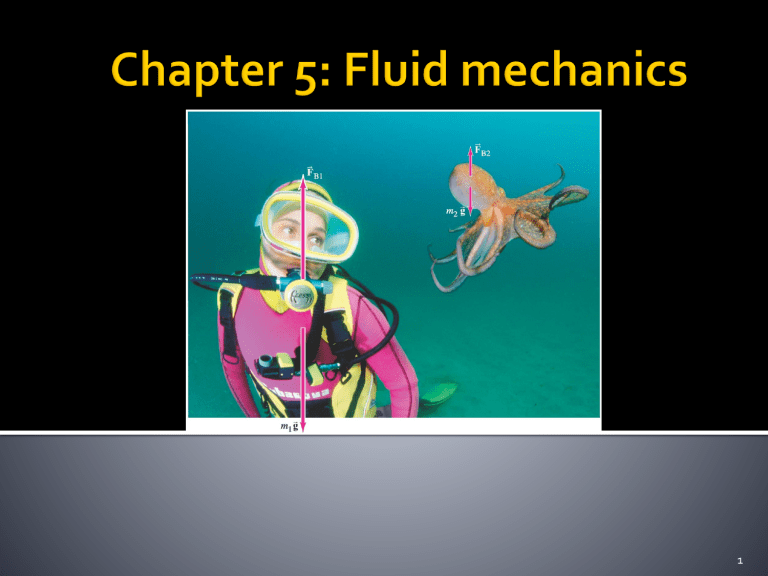
1
Mass, Density
Pressure
Buoyant Forces & Archimedes Principle
Pascal’s Principle
2
Solid
Matter
Gas
Introduction: Phases of matter
Liquid
3
Introduction: Fluids
Solid Liquid
• Fixed shape, fixed size
• does not readily change in shape or volume when force is applied
• does not maintain fixed shape (take the shape of its container)
• also not readily compressible
(volume can change with large force)
Gas
• neither fixed shape nor fixed volume (it’s expand to its container)
• compressible
Fluids
4
Introduction: Fluids
Fluid’s definition:
“ a substance which has
no definite shape
and
has the ability to flow
. Such as liquid and gas.”
5
Every matter occupies space around it
Space is called “ Volume (m 3 ) ”
Density
6
Density
Two objects made of the same material have the same density even though they may have different masses and different volumes .
That’s because the ratio of mass to volume is the same for both objects
7
Density
8
Density
Closely pack
more mass
Iron has more mass per unit volume
The density ρ of a substance is its mass per unit volume :
m v
The SI unit for density is kg/m 3 . Density is also sometimes given in g/cm 3 .
Density is a characteristic property of any pure substance.
9
Density
Object made of a particular pure substance, such as gold can have any size or mass, but the density will the same for each.
Why helium balloons float ?
Sometimes, we use the concept of density to write mass: m
v
..and hence the weight as: mg
vg
10
Example 1
What is the mass of a solid iron wrecking ball of radius 18 cm? Given the density of iron is 7800 kg/m 3 .
Volume of ball
Answer: m
v
4
3
r
3
7800 kg/m
3
4
3
2
18 10 m
3
190 kg
Density
11
Density
Exercise 1
1. What volume does o.4 kg of alcohol occupy? What is the weight of this volume?
2. What volume of water has the same mass of 100 cm 3 of lead? What is the weight density of lead?
Ans
3 5 3
12
Density
Exercise 2
1. Calculate the density of cubical solid if one of its side is 0.02 m and its mass is 0.50 kg?
2. Air has density of 1.29 kg m/3 under the room temperature. Calculate the mass of air in a cubical room if one of the sides of the room in 8m?
Pressure is defined as the force per unit area .
Concept
Pressure is a scalar; the units of pressure in the SI system are Pascal : 1 Pa = 1 N/m 2 .
14
15
Concept
Example 2
The two feet of a 60-kg person cover an area of 500 cm 2 .
(a) Determine the pressure exerted by the two feet on the ground.
(b) If the person stands on one foot, what will the pressure be under that foot?
16
Fluid pressure
Now, lets consider how the
pressure in a liquid of uniform density
varies with
depth
;
The pressure at a depth h below the surface of the liquid is due to the weight of the liquid above it. We can quickly calculate:
20
Fluid pressure
21
Fluid pressure
However, for the everyday situation of a liquid in an open container – such as water in the glass, a swimming pool, an ocean and etc, there is a free
surface at the top exposed to the atmosphere .
Absolute
Pressure
Thus, P = P₀ + ρgh
Atmospheric
Pressure
The atmospheric pressure at sea level is about
1.013 x 10 5 N/m 2 and decreases slowly with altitude .
25
Fluid pressure
Example 4
A swimming pool has a dimension of 28.0 m by 8.5 m whose uniform depth is 1.8 m.
Calculate the absolute pressure and the total force on the bottom of the pool.
27
Fluid pressure
Example 4: Answer
(a) Absolute pressure at the bottom of the pool:
P
P
gh
5
1000 kg/m
3
9.8 m/s
2
1.8 m
5
1.18 10 Pa
(b) Total force at the bottom of the pool:
F
PA
5
7
1.18 10 Pa 28.0 m 8.5 m 2.8 10 N
28
Exercise
Exercise 2
1. A Golf shoe has 10 cleats, each having an area of
6.5 ×10 -6 m 2 in contact with the floor. Assume that in walking, there is one instant when all 10 cleats support the entire weight of an 80 kg person, what is the pressure exerted by the cleats on the floor?
2. A pipe contains water under a gauge pressure of
400 kPa. If you patch a 4mm diameter hole in the pipe with a piece of tape, what force must the tape be able to withstand?
Ans
2
(2)5.03 N
29
Exercise
Exercise 2
3. The water pressure in a certain house is 1.1×10 6
N/m 2 . How high must be the water level be above the point to of release in the house?
4. What is the absolute pressure at the bottom of a lake that is 30 m deep?
Ans
5
: (3)112.24 m (4)3.95 10 Pa
30
Exercise
Exercise 2
5. A living room floor has floor dimensions of 4.50 m and 3.20 m and a height of 2.40 m. The density of air is 1.29 kg/m 3 . What does the air in the room weigh? What force does the atmosphere exerts on the floor of the room?
Ans
6
: 437 N, 1.46 10 N
31
Buoyant force
32
Buoyant force
Object submerged in a fluid appear to weigh less when its outside the fluid.
For e.g.: a large rock that you would have difficulty lifting off the ground can often be easily lifted from the bottom of a stream.
When its break through the surface of the water, suddenly its seems to be heavier.
This is the e.g. of the buoyant force .
33
Buoyant force
The buoyant force is an upward force exerted by the fluid .
34
The BF occurs because the pressure in a fluid increases with depth .
Thus, the upward pressure on the bottom surface of a submerged object is greater than the downward pressure on its top surface.
Buoyant force
35
Buoyant
F
B force
weight of
m
F
g
F
V
F g the fluid displaced
Where:
F
= density of the fluid
V
F
= volume of displaced fluid / volume of submerged object
Buoyant force
36
Consider:
At the top cylinder:
Pressure, P
1
= ρ
F gh
1 and Force,
F
1
= P
1
A = ρ
F gh
1
A
(downward)
At the bottom cylinder:
Pressure, P
2
= ρ
F gh
2 and,
Force, F
2
= P
2
A = ρ
F gh
2
A (upward)
Buoyant force
38
Buoyant force
Thus, the net force on the cylinder exerted by the fluid pressure is known as the act upward.
buoyant force, F
B and
The magnitude of F
B is;
Volume of the cylinder
Weight of the
Fluid displaced
39
Archimedes Principle
This result is
valid no matter what the shape of the object.
Archimedes’s Principle:
“ The buoyant force on an object immersed in a fluid is equal to the weight of the fluid displaced by that object.”
40
Archimedes Principle
“ Fluid displaced ” mean a volume of the fluid equal to submerged volume of the object ( or that part of the
object that is submerged )
For e.g.: if the object is placed in a glass or tube initially filled to the brim with water, the water that flows over the top represents the water displaced by the object.
41
Archimedes Principle
Example 5
Consider two identical pails of water filled to the brim. One pail contains only water, the other has a piece of wood floating in it. Which pail has the greater weight?
42
Archimedes Principle
Example 5
Consider two identical pails of water filled to the brim. One pail contains only water, the other has a piece of wood floating in it. Which pail has the greater weight?
Answer:
Both pail weigh the same .
According to Archimedes’ principle, the wood displaced a volume of water with equal weight of the wood.
43
Example 6
A 70-kg ancient statue lies at the bottom of the sea. Its volume is 3.0 x 10 4 cm 3 .
(a) What is the weight of the statue?
(b) What is the buoyant force exerted on the statue?
(c) How much force is needed to lift it?
Given the density for seawater, ρ = 1.1025 x 10 3 Kg/m 3 .
Archimedes Principle
44
Example 6: Answer
(a) Weight of the statue: w
mg
2
2
70 kg 9.8 m/s 6.9 10 N
(b) The buoyant force (equal to weight of displaced seawater):
F
B
m g s
Volume of seawater =
v g s s volume of statue
3
2 3
9.8 m/s
2
2
3.0 10 N
Archimedes Principle
45
Example 6: Answer
(c) Force to lift the statue:
F
mg
F
B
2
2
6.9 10 N 3.0 10 N
2
3.9 10 N
Archimedes Principle
46
Archimedes Principle
Example 7
A typical hot air balloon has a volume of 2200 m 3 .
The density of air at temperature 20°C is 1.205 kg/m 3 . The density of the hot air inside the balloon at a temperature 100°C is 0.946 kg/m 3 .
How much weight can the hot air balloon lift?
47
Example 7: Answer
The weight of the extra load can be found by: (refer to the FBD)
F
B
m g
B
w
L
w
L
F
B
m g
B
Thus, find the buoyant force exerted on the balloon:
F
B
m g
B
v g
A B
1.205 kg
2200 m
3
9.8 m/s
2
4
2.6 10 N
Archimedes Principle
F
B
W
L m
B g
48
Example 7: Answer
The mass of the balloon (equal to mass of the hot air inside): m
B
H v
0.946 kg/m
3
2200 m
3
2081 kg
Archimedes Principle
F
B and the weight: m g
B
2
4
2081 kg 9.8 m/s 2.0 10 N
W
L m
B g
Hence, the extra load: w
L
F
B
m g
B
4 4
6000 N
49
Archimedes Principle
Case 1: Totally submerged object
An object is totally submerged in a fluid if its density is greater than the density of the fluid ( ρ₀ > ρ
F
).
When an object is totally submerged, the upward F
B is:
F
B
v
Fluid Fluid displ g
v g
Fluid object
50
Archimedes Principle
If the object has a mass, m and density,ρ₀ thus,
F g
m object g
v g object object
Hence, the net force,
F
B
F g
v g
Fluid object
v g object object
Fluid
v g object object
When ρ₀ > ρ
F object sink!
, then F
B
< F g and the supported
51
Archimedes Principle
Case 2: Floating object
In general, an object floats on a fluid if its density is less than that of fluid ( ρ₀ < ρ
F
).
In this case, the upward buoyant force is balanced by the downward gravitational force ,
F
B
F g
v g
Fluid F displ
v g object object v
F displ v object
object
Fluid
52
Archimedes Principle
Example 8
A 100 g block of wood has a volume of 120 cm 3 . Will it float in water? Will it float in gasoline?
53
Archimedes Principle
Example 8: Answer
Lets compare the buoyant force with the weight:
Weight of the block: m g
B
3
2
0.98 N
Buoyant force by the water:
F
B
v g w B
1000 kg/m
3
6 3
9.8 m/s
2
1.176 N
Since FB > mg, it will float in water.
54
Archimedes Principle
Example 8: Answer
Buoyant force by the gasoline:
F
B
v g g B
680 kg/m
3
6 3
9.8 m/s
2
0.78 N
Since FB < mg, it will sink in gasoline.
55
Archimedes Principle
Example 9
A scuba diver and her gear displace a volume of 65.0
L and have a total mass of 68.0 kg.
(a) What is the buoyant force on the diver in seawater?
(b) Will the diver sink or float?
.
Given the density for seawater, ρ = 1.025 x 10 3 Kg/m 3
56
Example 9: Answer
(a) Buoyant force on the diver:
F
B
v g s d
3 3
0.065 m
3
9.8 m/s
2
653 N
Archimedes Principle
(b) Will the diver sink/float?
m g
d
2
666 N
Thus, since the weight > buoyant force, the diver will sink!
57
Archimedes Principle
Exercise 3
A crane lift the 16,000 kg steel hull of a sunken ship out of the sea. Determine:
(a) the buoyant force exerted by seawater on the hull
(b) the tension in the crane’s cable when the hull is fully submerged in the water
(c) the tension when the hull is completely out of the water?
[Given the density for seawater, ρ = 1.1025 x 10 3 Kg/m 3 and density of steel, ρ = 7.8 x 10 3 Kg/m 3 ]
Ans
4 5 5
: (a) 2.2 10 N (b) 1.34 10 N (c) 1.56 10 N
58
Archimedes Principle
Exercise 4
A tin coffee can floating in water has an internal volume of 180 cm 3 and a mass of 112 g. How many grams of metal can be added to the can without causing it to sink in the water?
Ans : 68 g
59
Pascal’s Principle
60
Pascal’s Principle
In fact that the pressure in a fluid depends on depth and the atmospheric pressure P₀, any increase in pressure at the surface must be transmitted to every other points in fluid.
Pascal’s principle:
“If an external pressure is applied to a confined fluid, the pressure at every point within the fluid increases by
that amount”.
A change in pressure at any point in an enclosed fluid is transmitted equally throughout the fluid.
61
Pascal’s Principle
Some application of Pascal’s Principle: a) Hydraulic lift which a small input force is used to exert large output force
62
Pascal’s Principle
The pressure must be same for both piston.
P in
P out
Since the pressure is define as force per unit area:
F in
F out
A A in out
The mechanical advantage: F out
A out
F A in in
63
Pascal’s Principle
Example 7
In a car lift used in a service station, compressed air exerts a force on a small piston that has a circular cross section and a radius of 5.0 cm. This pressure is transmitted by a liquid to a piston that has a radius of 15.0 cm.
What force must the compressed air exert to lift a car weighing 13,300 N? What air pressure produced this force?
65
Example 7: Answer input force: F in
F out
A in
A out
4
1.33 10 N
3
1.48 10 N pressure due this force:
P in
F in
A in
3
1.48 10 N
2
5 10 m
2
5
1.88 10 Pa
2
2
2
2
Pascal’s Principle
66
Pascal’s Principle
Exercise 5
A force of 400 N is applied to a small piston of hydraulic press whose diameter is 4 cm. What must be the diameter of the large piston if it is to lift a 200 kg load?
0.088
m
67
